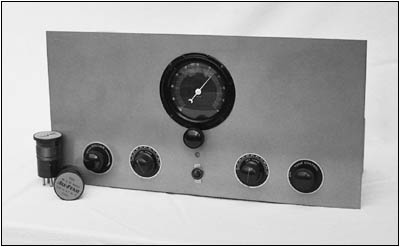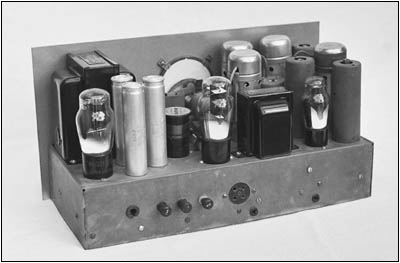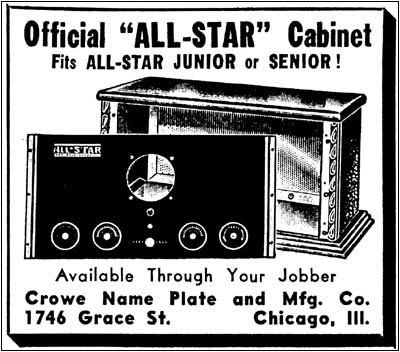Of Old Radios And Related Items--Published Monthly
THE 1934 "ALL-STAR" KIT RADIO
BY THOMAS BOYD
Web Edition
Tom Boyd revives a bit of radio history for us. Kit radios of the 1930s are not common, and so Tom's research about his All-Star kit find in Texas makes interesting reading. (Editor)
Kit radios have been around since the 1920s, appealing to hobbyists and the cost-conscious alike. The shortwave craze of the 1930s helped fuel the kit market, and a variety of all-wave receiver kits can be seen advertised in magazines of the period, such as Short Wave Craft, Radio News and Short Wave Radio, and others. Unfortunately, few of these kit radios seem to have survived.
A number of years ago, I purchased a piece of old tube gear in an antique store in Austin, Texas. Although clearly a receiver, it had no markings indicating its manufacturer. I brought it home and began poring through books and old magazines in hopes of identifying it. Before long, I spotted it in Moore's volume on communications receivers -- it was an All-Star, a kit radio from the mid-1930s, shown in Figures 1 and 2. Further research revealed quite a bit more.

Figure 1. The front panel of the All-Star. Left to right, the four controls along the bottom: volume, antenna tuning, oscillator tuning, and tone. The airplane dial is for bandspread and provides a 0-100 logging scale over a 270 degree arc.
In the fall of 1934, Laurence M. Cockaday, editor of Radio News and Short Wave Radio, began advertising an all-wave kit radio, which he dubbed the "All-Star," as seen in Figure 3 (see print version). Initially, he had a group of eight suppliers behind his venture, but this number quickly grew to eleven. The list included some familiar names and some not-so-familiar: Thordarson, Cornell-Dubilier, Hammarlund, Meissner, Ohmite, Belden, Electrad, Crowe Name Plate & Mfg., Erie Can, Oxford Radio, and Oak Manufacturing. The kit could be obtained through most jobbers, some of whom advertised in his magazine.
The Complete All-Star Kit
A complete All-Star kit included a prepunched and drilled front panel and chassis, along with all components and hardware. Tubes and speaker were extra, as was typical of the period. Alternatively, builders could elect to purchase a "foundation kit" consisting of just the chassis and front panel at a cost of $2.50, and then choose their own parts sources. An optional wood cabinet for the All-Star was offered by Crowe Name Plate and Mfg. Co., as shown in Figure 4.

Figure 2. A rear view of the All-Star.
The All-Star was originally designed as a 6-tube superheterodyne receiver with a tuning range of 10 to 550 meters using factory-wound, plug-in coils. The tube line up consisted of a 2A7 converter; two IF stages, each with a 58; a 56 detector; a 2A5 audio output; and an 80 rectifier. An optional BFO was soon made available, requiring the use of an additional 58.
The All-Star was designed with an intermediate frequency of 370 kHz, a choice that is unusual, if not unique. It certainly results in a poor image ratio, especially for the higher frequencies.
The All-Star and 1934 Technology
The All-Star hardly represented the latest in radio technology, 1934-style. The oscillator and mixer sections are tuned separately, and there is no AVC, a feature already common in consumer radios by 1934. The optional BFO can only be switched on and off -- there is no convenient means of varying the pitch, although an adjusting nut can be accessed at the top of the BFO coil can. There is no direct dial calibration -- all three tuning scales are simply marked 0-100.
These simplifications no doubt helped keep the cost down, and resulted in an easy-to-assemble kit. As Cockaday stated in a marketing blurb, the kit was "to be built by radio enthusiasts of small experience."
Minor variations can be found in the schematics that appeared over the several months the kit was marketed. One, probably the earliest, shows neither the optional BFO nor provision for a headphone jack, while the others show both. The values of some of the resistors and capacitors differ from one version to another. The September 1934 editions of both Short Wave Craft and Radio News and Short Wave Radio show a 5Z3 rectifier, instead of the 80 shown in other schematics. These differences seem to signal that the All-Star's development period was short and that the kit was rushed to market.

Figure 4. Advertisement for the Crowe Name Plate and Mfg. Co.'s "Official All-Star cabinet." ("Radio News and Short Wave Radio," March 1935)
My All-Star had been built with the optional BFO and came with about half the original plug-in coils. I have since acquired a couple of additional coils with the help of fellow hobbyists. Cleaned up and repaired, it now enjoys light duty for shortwave listening, though Cockaday's enthusiastic claims about its performance seem a bit overstated.
It seemed that the All-Star had hardly arrived when in the spring of 1935 Cockaday introduced a revised model, the All-Star Junior, a 5-tube set using the newer 6-volt tubes (6A7, 42, etc.). Many basic features were retained, however, like the separate oscillator and mixer tuning, the 370 kHz IF, and the plug-in coils. The Junior model was also distinguished from the original by its black front panel and slightly different knobs.
The price of a complete All-Star kit (less tubes, speaker and cabinet) was about $31 or so, varying slightly depending on the jobber. There were less expensive 6-tube "all-wave" kits advertised in 1934, but having his own magazine gave Cockaday an effective sales tool. A note in the Thordarson Transmitter Guide of this period claimed that "over 6,000 units have been built." Credible figure or not, it is certain that far fewer have survived.
References:
All-Star News. Undated promotional material, c. 1934.
Cockaday, Laurence M. "The 'All Star' All-Wave Receiver." Radio News and Short Wave Radio, Sept. 1934, pp. 146 ff.
Cockaday. "Operating Data on the 'All-Star' All-Wave Receiver" Radio News and Short Wave Radio, Oct. 1934, pp. 235 ff.
"The All-Star Super-6." Short Wave Craft, September, 1934, pp. 285 ff.
Thordarson Transmitter Guide. Reprinted by Lindsay Publications, Chicago, IL, 2000, p. 28.
Moore, Raymond S. Communications Receivers. 4th Edition, 1997, p. 136.
(Thomas Boyd, 3910 North 37th St., Tacoma, WA 98407)
After subscribing to A.R.C. for about a decade, Tom Boyd decided to try his hand at writing an article for the magazine. Needless to say, we are delighted at the result. Tom began collecting and restoring antique radios in the late 1980s after finding the RCA tombstone his father had bought new in the mid-1930s stored in his parents' attic.
| [Free Sample] [Books, etc., For Sale] [Subscribe to A.R.C./Renew] [Classified Ads] [Auction Prices] [Event Calendar] [Links] [Home] [Issue Archives] [Book Reviews] [Subscription Information] [A.R.C. FAQ] URL = http://www.antiqueradio.com/Aug03_Boyd_AllStar.html Copyright © 1996-2003 by John V. Terrey - For personal use only. Last revised: August 23, 2003. For Customer Assistance please contact ARC@antiqueradio.com or call (866) 371-0512
Antique Radio Classified |